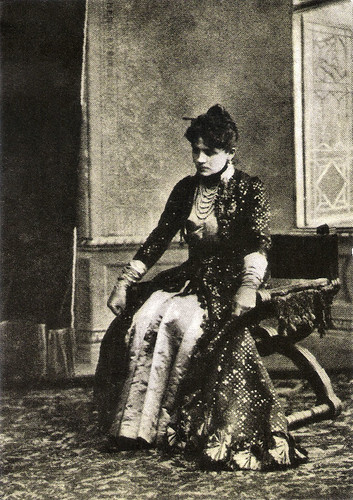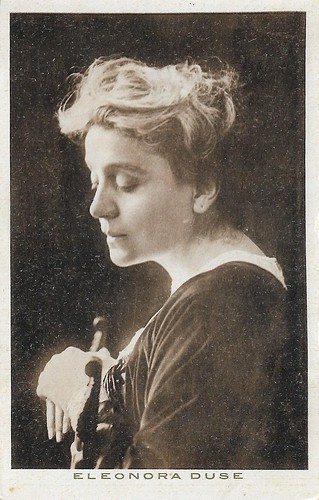
Vintage postcard, no. 7402. Sent by mail in Sweden.

French collectors card by Collection Félix Potin, series 1 (c. 1900).

Austrian postcard by Hanfstaengl Künstlerkarte. Eleonora Duse with Marion Lenbach, painted by Franz von Lenbach.

Italian postcard by Ed. Vettori, Bologna, no. 400.

Vintage postcard by B.K.W.I.
A clear Italian twist
Eleonora Duse, also called simply 'Duse' or 'la Duse', was the daughter of wandering artists. At the age of four, she already played Cosette in Victor Hugo's 'Les Misérables' and at the age of 15, she played the lead in 'Romeo and Juliet' in the Arena of Verona. In 1878 she joined the Blanes/Ciotti company.
Her breakthrough as an actress came with the lead in the stage adaptation of Emile Zola's 'Thérèse Raquin'. In 1879 she joined the Turinese Compagnia Semistabile led by Cesare de Rossi, where she clearly broke with the tradition of acting in the grand style.
She selected a repertory that was partly that of her rival Sarah Bernhardt but gave it a clear Italian twist and social critique. Thus, she commented upon the hypocrisy of late 19th century Italian society where money ruled; a world in which real expression of emotions was impossible.
In 1881 Eleonora Duse married actor Tebaldo Cecchi, and had a daughter with him: Enrichetta, but the marriage ended in divorce. In 1884 she had a secret affair with Arrigo Boito, best known for his libretti for Giuseppe Verdi's operas.
Boito adapted William Shakespeare's 'Anthony and Cleopatra' and 'Macbeth' for her. The affair did not last but they remained friends for life. After that, she had a relationship with lesbian feminist Lina Poletti, and her friendship with dancer Isadora Duncan was also suspected to be more than just that.
Vintage postcard by RPA, no. 7399.
Italian postcard, no. 127. Photo: Sciutto, Genova. The postcard was mailed in Bologna on 20 November 1911. Photo: still from the play 'La città morta' (The Dead City) by Gabriele D'Annnunzio, starring Eleonora Duse. The photo was made for the performance of Duse in Genoa, Teatro Paganini, in April 1901. The blind Anna holds Bianca Maria onto her lap. She understands that the girl is in love with her own husband Alessandro.

Italian postcard, no. 128. Photo: Sciutto, Genova. Publicity still for the play 'La città morta'. Collection: Didier Hanson.

German postcard by G.G. (Georg Gerlach) & Co., Berlin, no. 693.

French postcard.
A tempestuous affair
In the 1880s, Eleonora Duse became an international star. First, she had Italian acclaim in 1884 with the theatrical adaptation of Giovanni Verga's 'Cavalleria rusticana', which later became a famous opera by Pietro Mascagni. Then she did a tour through South America in 1885, followed by tours to Egypt, Spain, North America, the UK, Austria and Germany. In Russia, Anton Chekhov was amazed by her acting. In 1891 she did her first performance of 'Nora' by Henrik Ibsen, the first of her many interpretations of the new Scandinavian theatre.
In 1894 she met author Gabriele D'Annunzio again, after having encountered him twice before. In 1882, at their first meeting, D'Annunzio bluntly asked her to make love with him; she declined but was still aroused. In 1888, while she was retreating to her dressing room and still in tears after her performance in 'La Signora delle Camelie' (Camille), he startled her by declaring his admiration. At their third meeting in Venice in 1894, they started a tempestuous affair.
Duse performed in several plays by D'Annunzio: 'Il sogno di un mattino di primavera' (The Dream of a Spring Morning), 'La Gioconda', 'Francesca da Rimini', 'La città morta' (The Dead City), and 'La figlia di Jorio' (The Daughter of Jorio). D'Annunzio gravely offended her though by giving the lead in the French premiere of 'La città morta' to her arch rival Sarah Bernhardt.
After that, collaborations and crises alternated. D'Annunzio was unfaithful and openly gossiped about his private affairs. In 1900, he published the novel 'Il fuoco' (The Fire) about an older actress having affairs with younger men, obviously inspired by his relationship with Duse. Her fans were not amused. Duse became more and more depressed about the hopeless affair, and in 1904, after the premiere of 'La figlia di Jorio', she broke up with him.
Instead, Eleonora Duse concentrated on her acting, in particular in plays by Henrik Ibsen, and she did a Scandinavian tour in 1906. In 1909 she abruptly halted her stage career and retired to her villa in Asolo, Italy.

German postcard by Kunstanstalt Voremberg, Berlin (K.V.i.B.), in the Serie Monna Vanna, sent by mail in 1903. Eleonora Duse in the play 'Monna Vanna' (1902) by Maurice Maeterlinck. The actor is probably her co-star in the play, Ciro Galvani.

Italian postcard by Edizioni Zane, Venezia, no. 6276. Caption: Eleonora Duse e il suo tempo (1858-1924) Mostra al Museo Civico di Asolo: 14 sett. 31 ott. 74. (Eleonora Duse and her time (1858-1924) Exhibition at the Museo Civico di Asolo: 14 Sept. 31 Oct. 74).

German postcard.

German postcard by ALBS.

German postcard in the Collection Das grosse Jahrhundert by Vereinigte Papierwaaren Fabriken S. Krotoschin, Görlitz, Serie B, no. 24. Caption: Eleanora Duse, born 3 October 1859 in Vigerano (Italy). The famous and much-admired actress guest performed in nearly every country of the civilised world.
Divine before Garbo
During the First World War, Eleonora Duse played in her sole film, Cenere/Ashes (Febo Mari, 1916), an adaptation of Grazia Deledda's novel, situated in Sardinia. A mother of humble descent cannot face the son she once gave away and who has now tracked her down. She eventually kills herself.
Despite Duse's presence and the location shooting in Sardinia, the film was not a huge success - actor-director Febo Mari's overacting might have had to do something with it. Afterwards, Duse had the perspicacity to recognise that film is a modern medium which requires a different acting style. She liked D.W. Griffith's direction of actors and his predilection to play with shadows, but despite their professional correspondence, the two could have collaborated better.
Copies of Cenere still survive, and even a tinted version was restored by the Cineteca del Friuli in Gemona, Italy. Forced by financial problems, Duse returned to the stage in 1921 with the play 'La donna del lago' (The Lady of the Lake). The young Luchino Visconti, the future stage and film director, was surprised by her restrained acting. The play was a massive success and after performances in Vienna and London, the already worn-out Duse started a five-week tour through the US in 1923.
The strain of the tour contributed to her death. In Pittsburgh, she died due to a severe pulmonary on 21 April 1923. Eleonora Duse was 65. She is buried in Asolo, Italy. Today, she is considered one of the major precursors of Method Acting, of eliminating yourself to get into the character; purely using your body to express emotions, without unnecessary props.
George Bernhard Shaw ranked her higher than Sarah Bernhardt, artists such as John Singer Sargent painted her portrait, and writers such as Rainer Maria Rilke and Hugo Von Hofmannsthal adored her. Duse was the first actress to be received at a tea at the White House (1896) and she was also the first woman gracing the cover of the new Time Magazine (1923). Way before Greta Garbo, Eleonora Duse was already entitled 'divine'.

Italian postcard by G. Modiano & Co., Milano, no. 30666.

Italian postcard by GB.
Vintage postcard.
Scene from Cenere/Ashes (1916). Source: Giovanni Ceccarelli (YouTube).
Scene from Cenere/Ashes (1916). Source: Madola56 (YouTube).
Sources: Wikipedia (English, German and Italian) and IMDb.
This post was last updated on 3 February 2024.
No comments:
Post a Comment